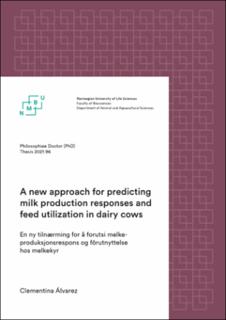| dc.description.abstract | Feed evaluation systems (FESs), such as the Nordic Feed Evaluation System (NorFor), aim to help dairy producers compare the nutritive value of various types of feed, formulate of balanced diets, and predict animal performance given a certain diet. To cover the changing demands of the dairy industry, FESs are in continuous need of improvement and updating. Therefore, this thesis contributes to improving NorFor by developing a model that can estimate the energy content of compound feeds and the development of a model describing milk production responses to the changes in silage digestibility and concentrate intake. The practical use of this knowledge is central because the common goal is to implement them into NorFor for use in farms.
For the development of the energy estimation model of compound feeds, the activities are described in two scientific articles (Papers I and II). Paper I show that the enzymatic digestibility of the organic matter method (EDOM) is precise for the determination of organic matter digestibility (OMD) of compound feeds, here with a high correlation between measures of a sample within and between labs. This is vital for use in practice because a high correlation between the measurements of a sample means that values can be compared between countries and through time. Thus, is a viable method if OMD is to be included in the energy estimation equation developed in Paper II. The best fit model (2.08% RMSE) for estimating the net energy of lactation at 20 kg DM (NEL20) of compound feeds include OMD measured by EDOM and the chemical components crude fat, NDF, and crude protein (urea corrected) as the explanatory variables. The model can be used as an alternative when information about ingredients for the calculation of NEL20 in the mechanistic model is lacking.
For the development of the responses in milk production regarding changes in diet, a meta-analysis was developed in Paper III. The meta-analysis showed a curvilinear response of ECM to concentrate intake. Hence, ECM showed a decreasing increment to concentrate intake. This marginal response was also affected by silage digestibility, showing lower responses with increasing silage digestibility. Paper IV is the result of an animal experiment involving 60 Norwegian Red cows. The objective was to test the meta-analysis by feeding two silages with different digestibility and concentrate levels. Milk production, intake, and methane emissions were measured throughout the experiment. The
x
silage with a higher digestibility was able to maintain high milk yields with low concentrate supply levels, but this could not be achieved with silage with lower digestibility. When the concentrate supply was increased, low-digestible silages showed a higher response in milk production. Cows in the high-digestible silage treatment were offered a lower concentrate supply, but the methane production did not differ between the silage treatments. Methane per unit of feed and milk decreased with increasing total intake, regardless of the type of silage or level of concentrate.
Paper V produced, based on the meta-analysis, a developed response approach that could be adapted to farm data, here by transforming the responses variable—ECM—into concentrate efficiency responses. According to an algorithm developed using machine learning, silage is classified as high or low digestibility. A silage is classified as highly-digestible because of the steeper decrease in concentrate efficiency with the increase in concentrate supply because of lower marginal milk responses. The algorithm also allows the evaluation of the concentrate efficiency for a specific silage use in farms at both, group and individual cow level. An economic response approach was also developed, showing that for highly-digestible silages, the optimal concentrate supply level is sensitive to changes in concentrate prices. | en_US |
